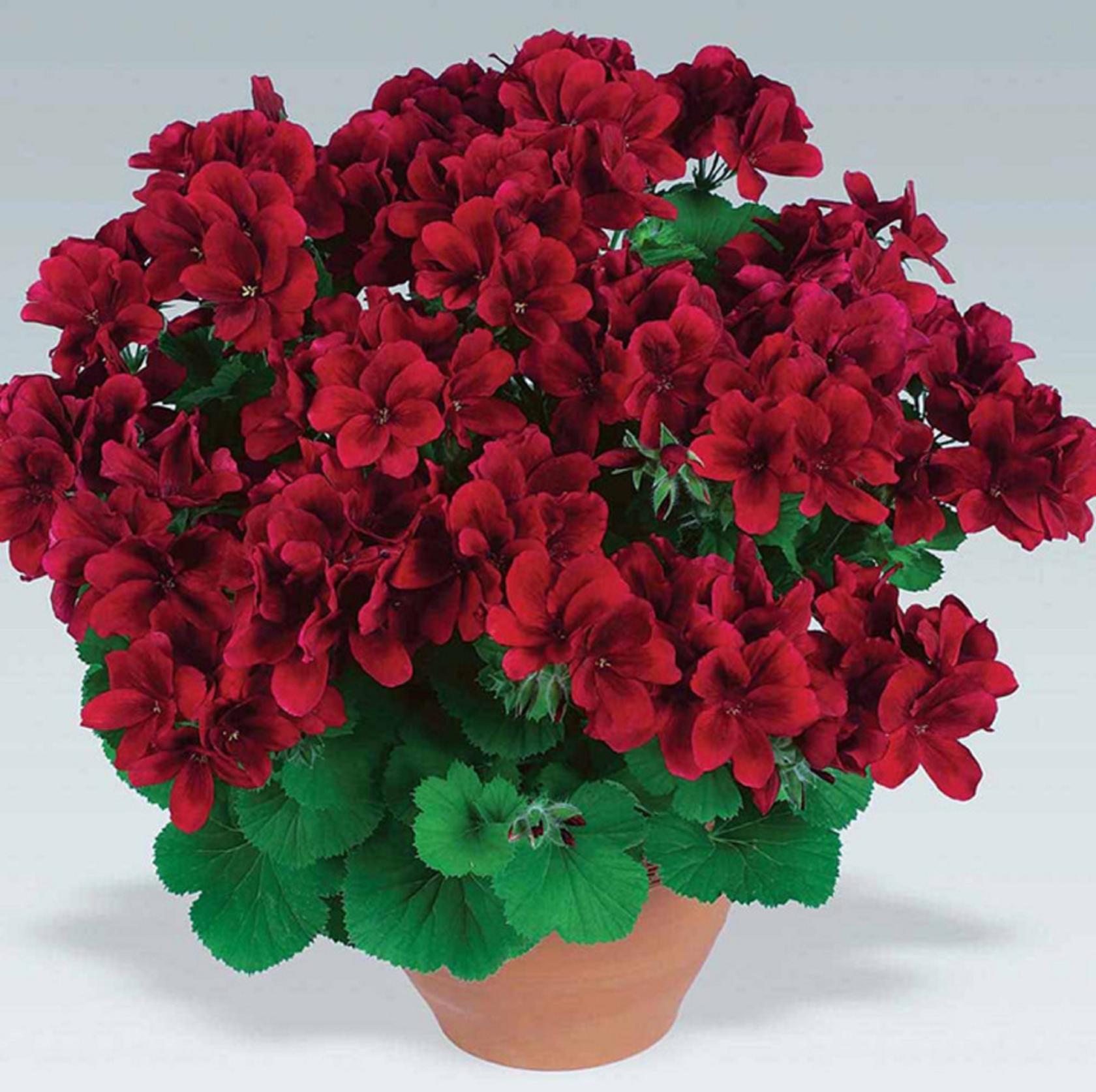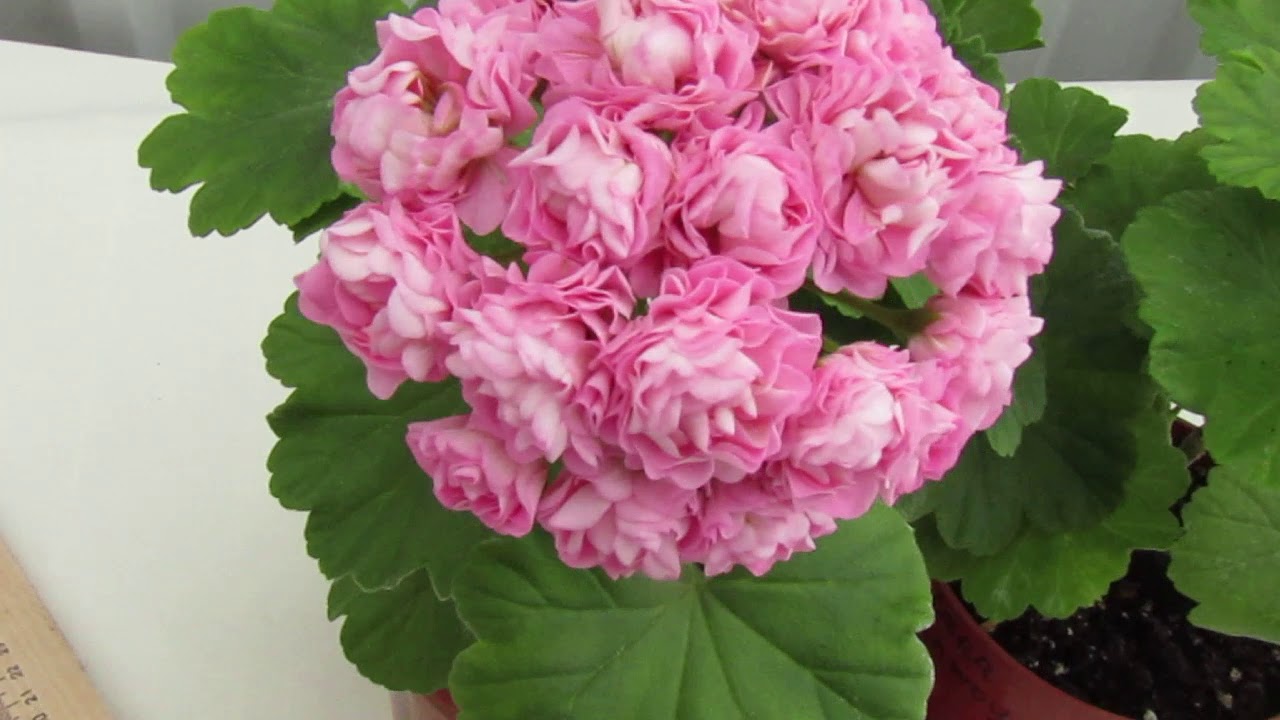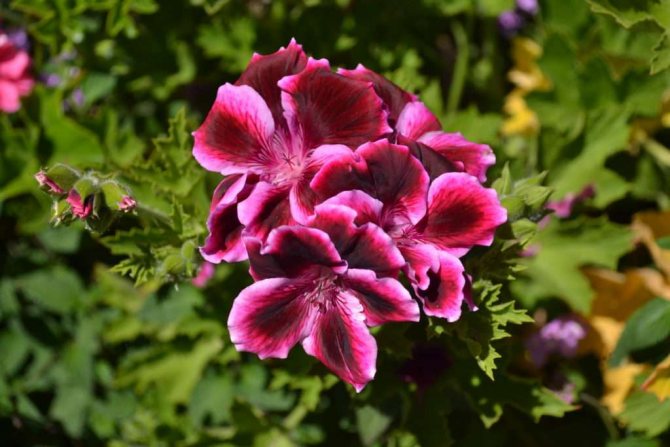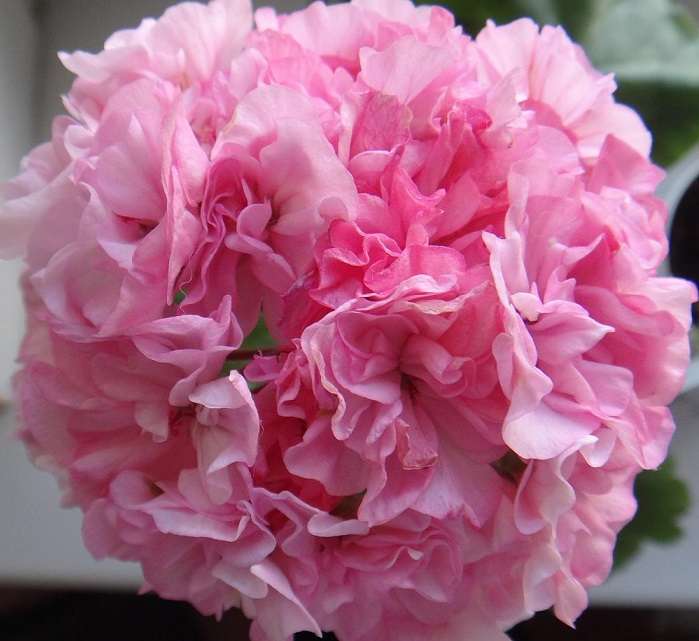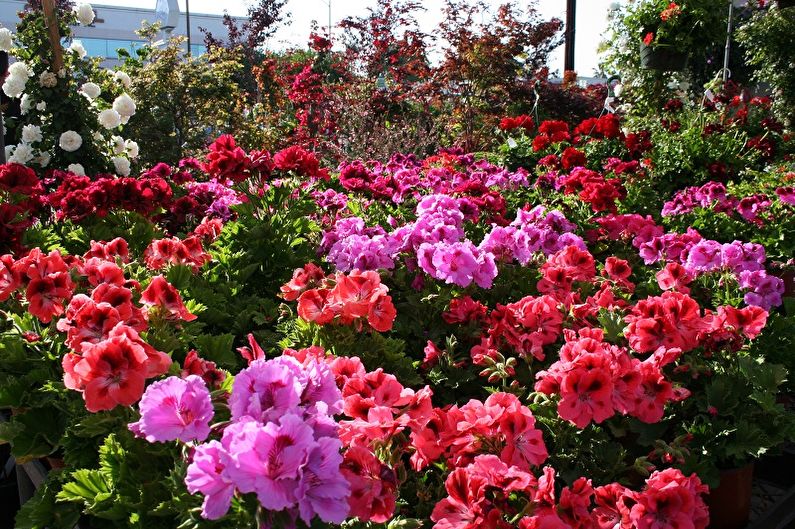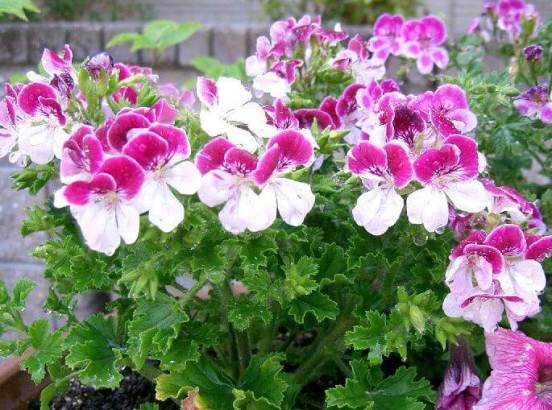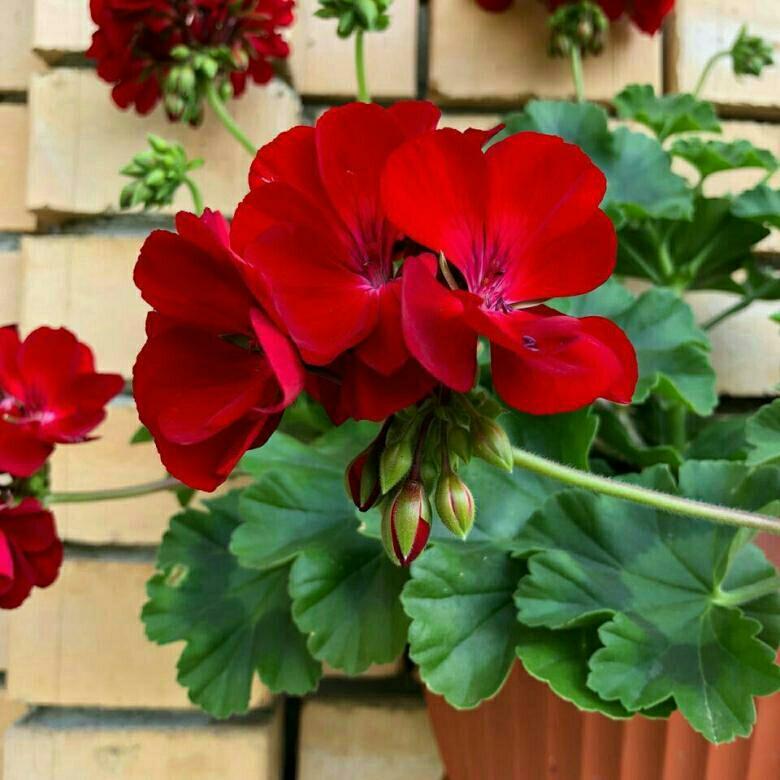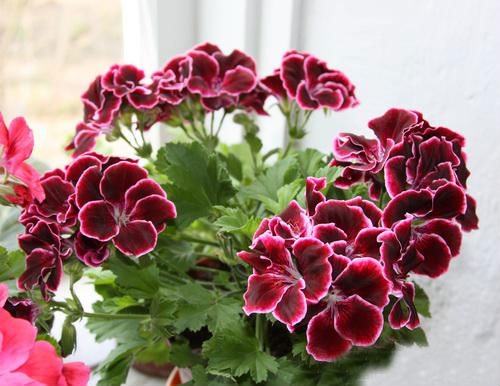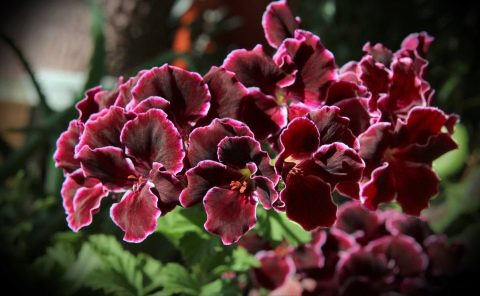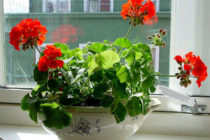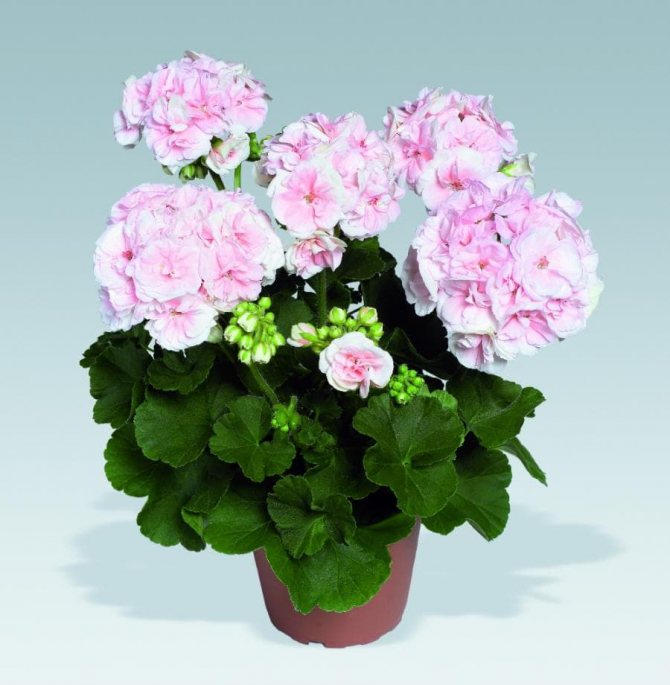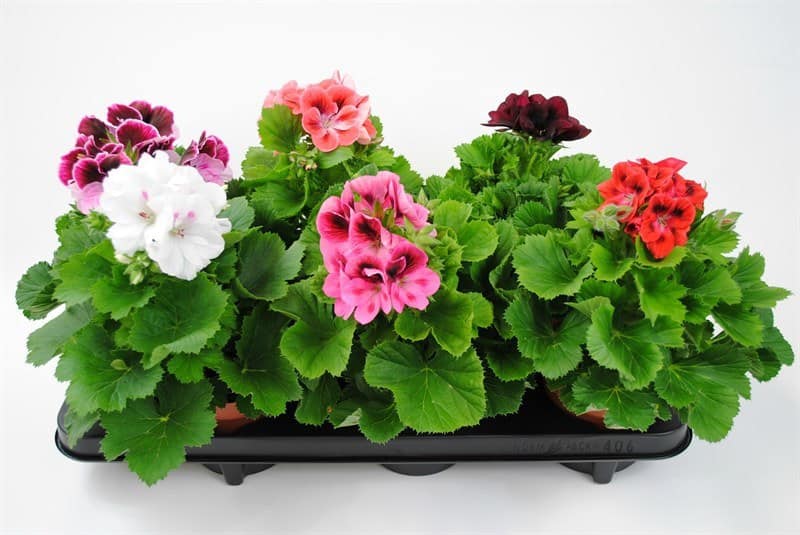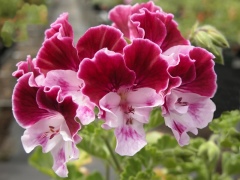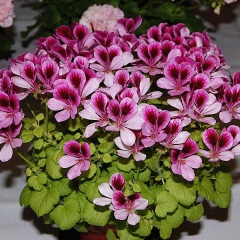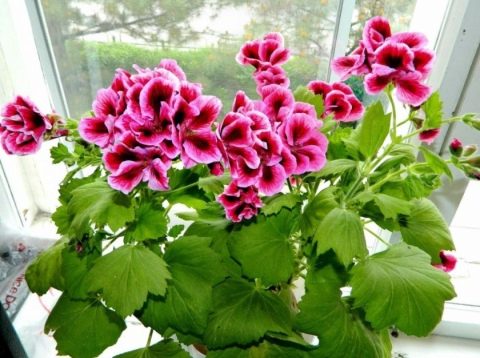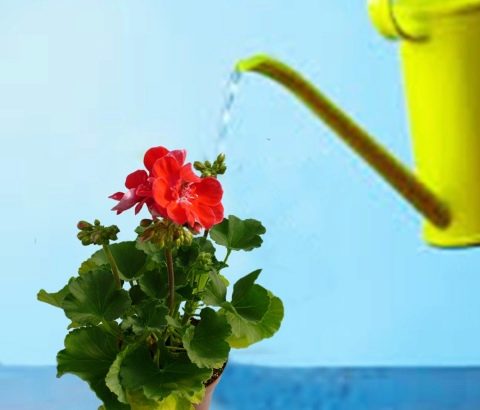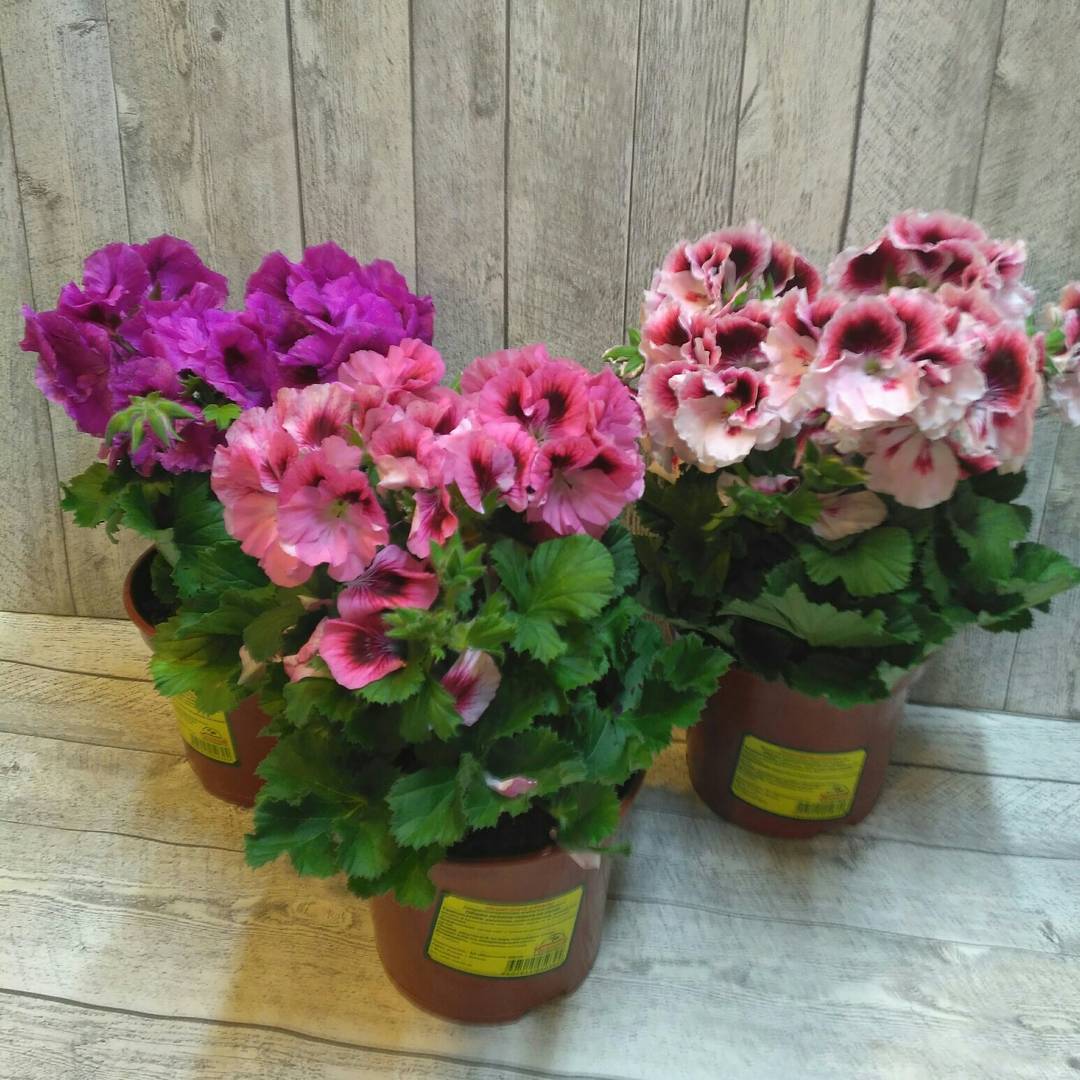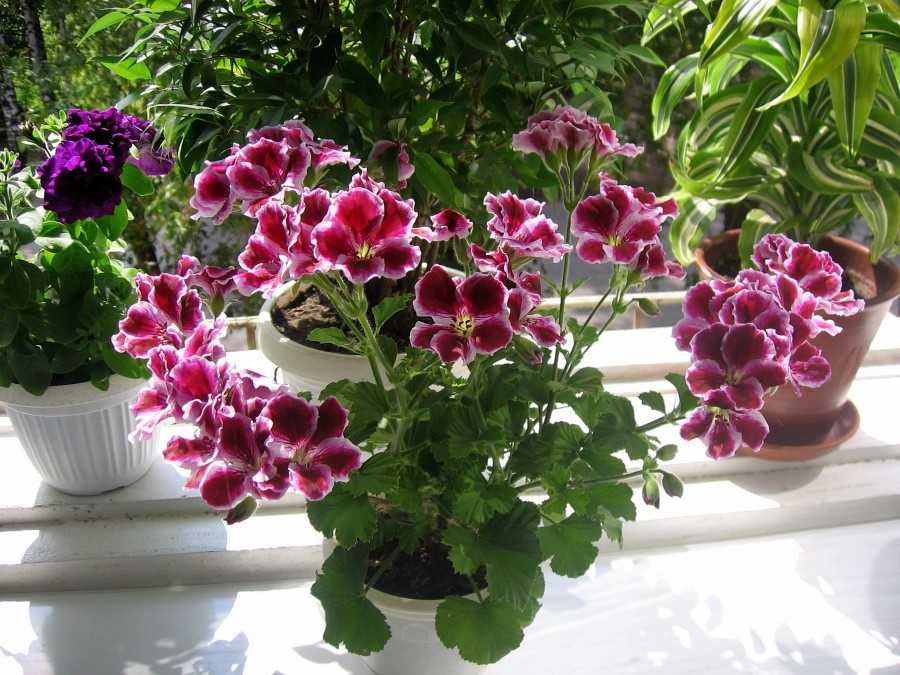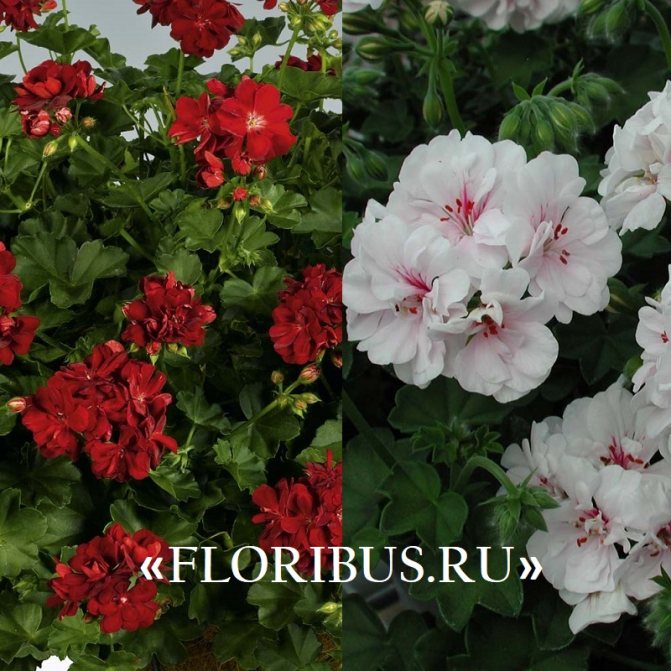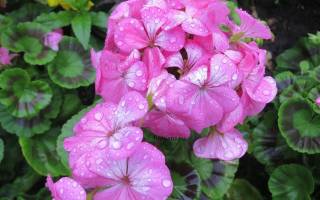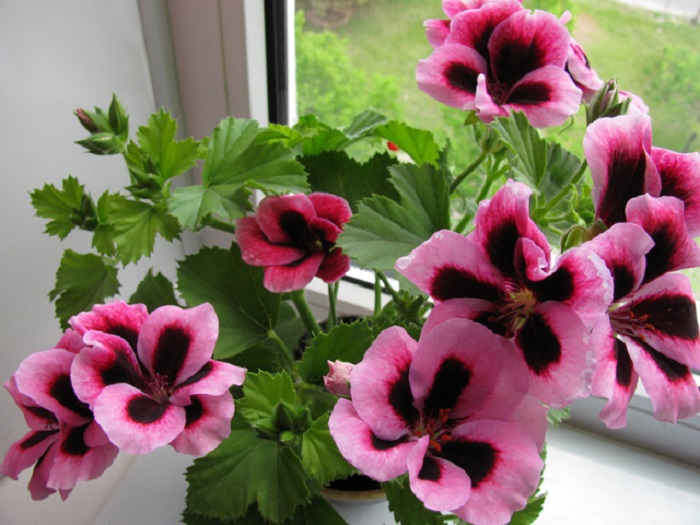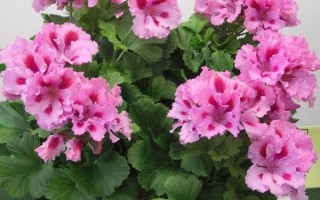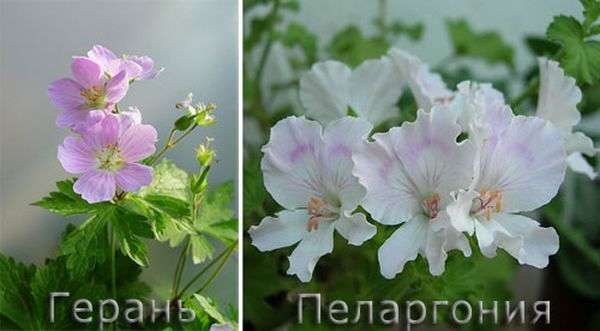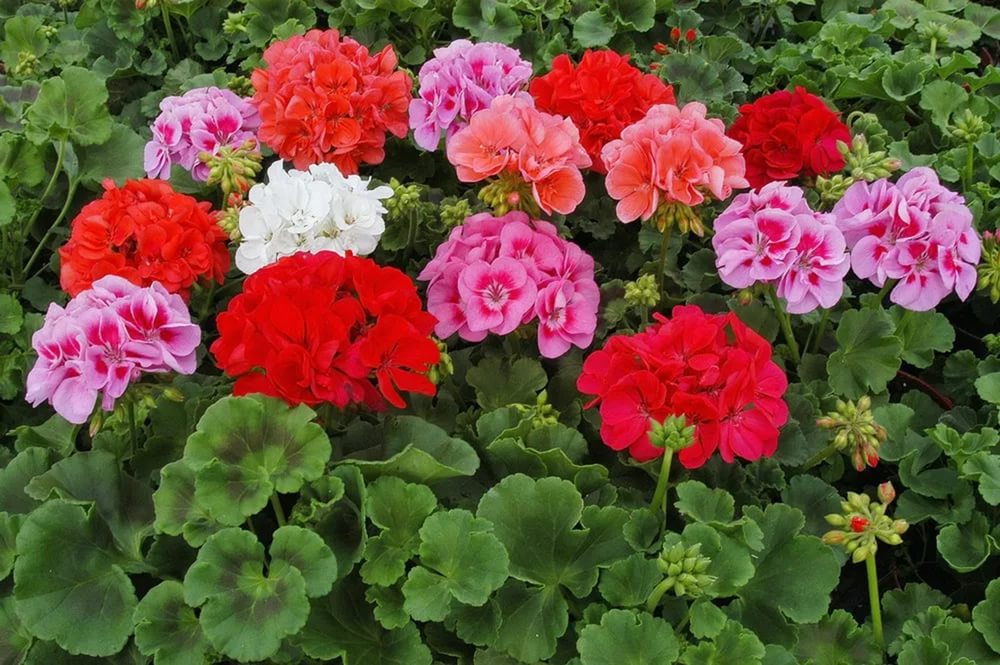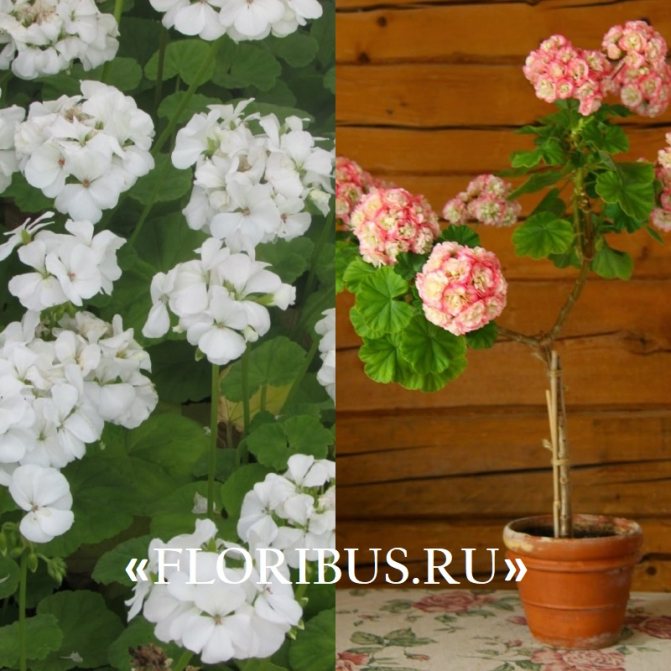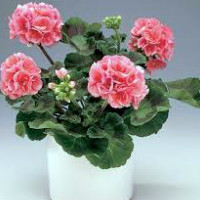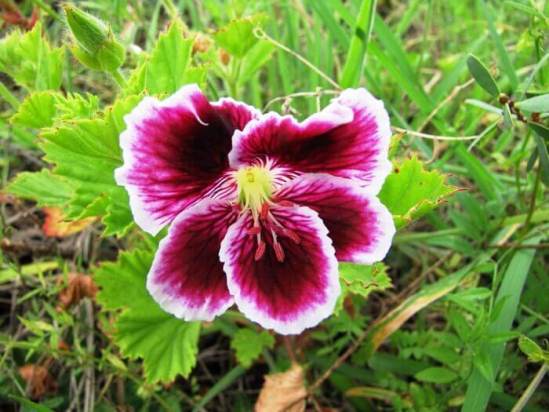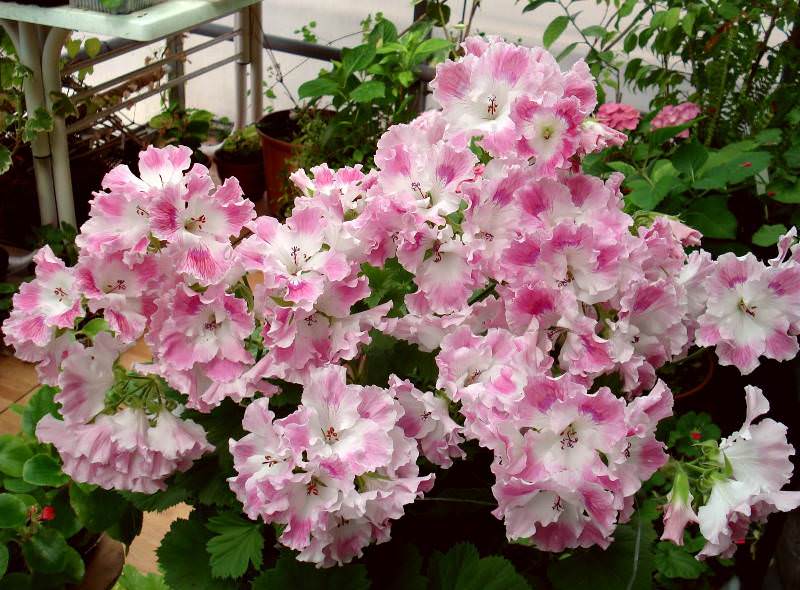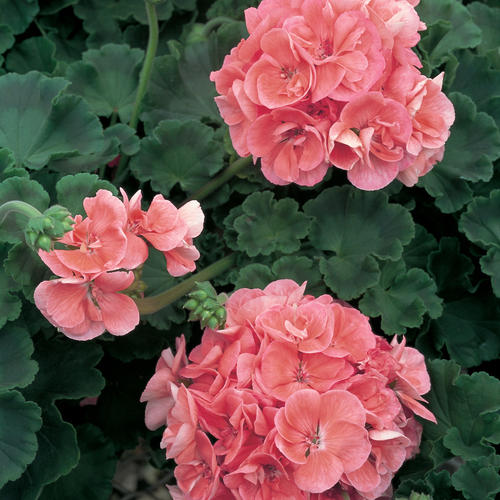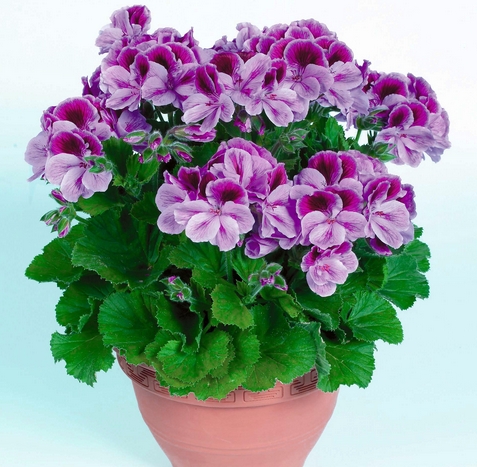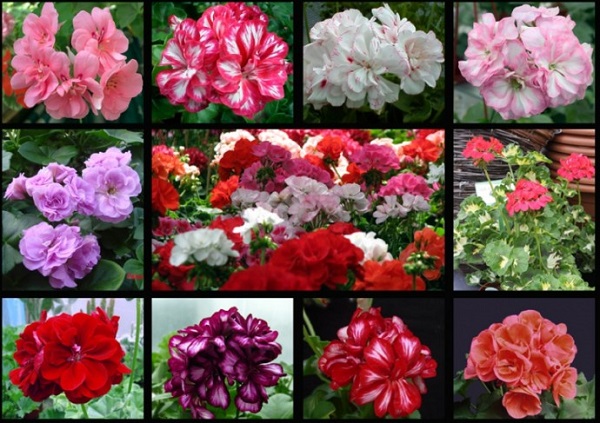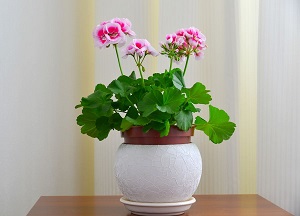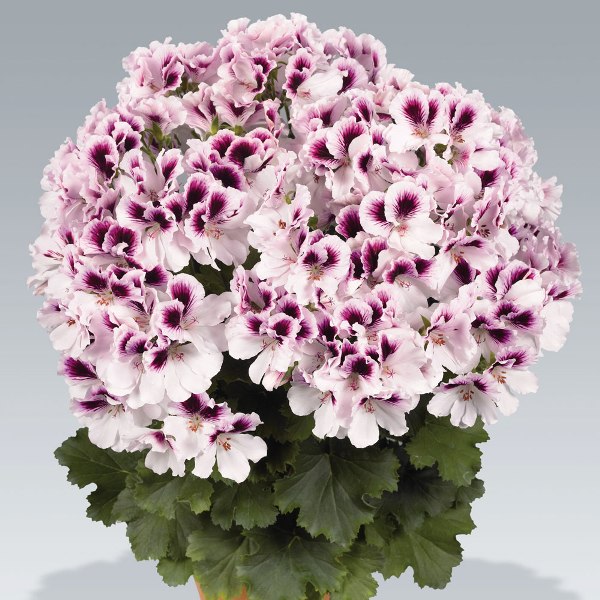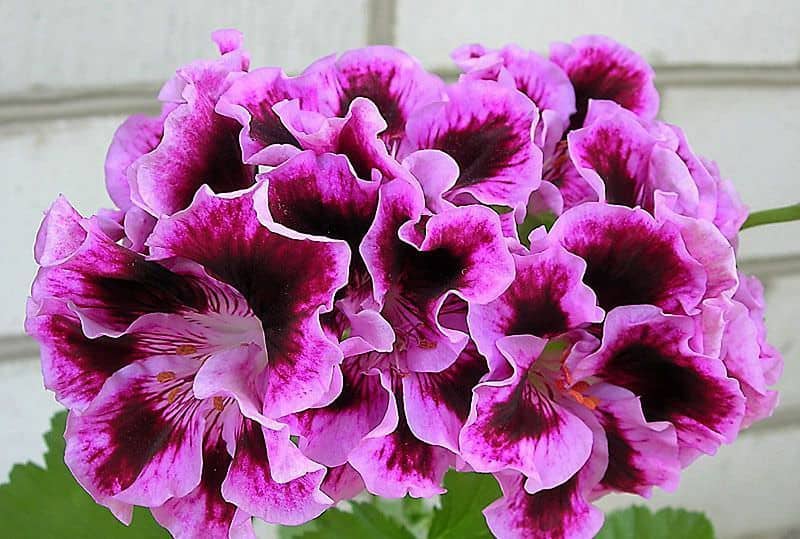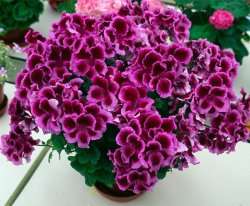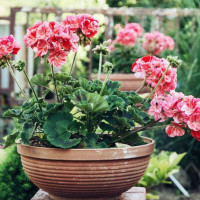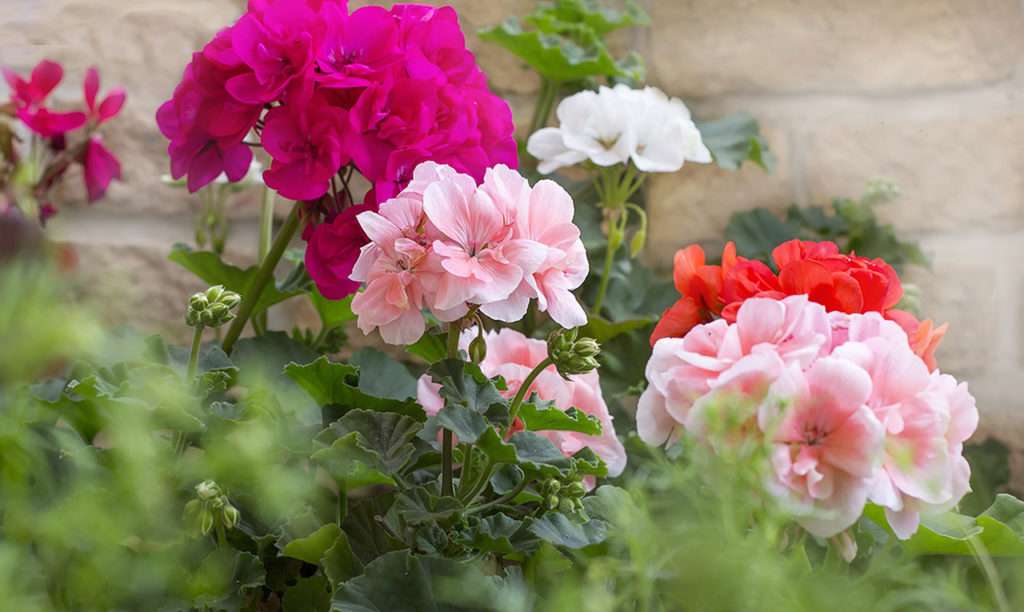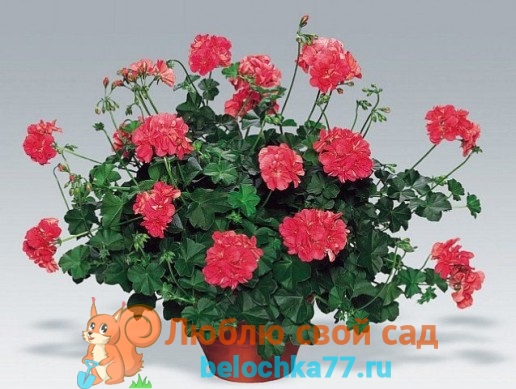When and how it blooms
The flowering of royal geraniums is a true delight for flower growers. She is able not only to look great, but also to exude an amazing subtle scent.
Types of flowers
The flowers of the royal geranium can be not only classic, but also double. There are even specimens with corrugated inflorescences. The variety of their colors is simply amazing. The following shades can be presented:
- yellow;
- pink;
- Red;
- purple;
- Orange;
- White.

Royal geraniums have a wide range of colors
Flower shapes
The royal flower for the most part has flat and concave petals on the inflorescences, but in some varieties they are wavy. This makes the plants even more attractive and exquisite.
Flowering period
Unlike other varieties, king geraniums have a shorter flowering period. Its duration does not exceed six months. The beginning of flowering coincides with the onset of spring.
How to make bloom at home
In order for the royal geranium to bloom at home, its pot must be a little cramped. The plant also needs a dormant period. Otherwise, it will weaken and will not drown in flowers in the next season. Timely fertilization, adequate watering, and adequate lighting are also prerequisites for flowering.
Pruning for lush bloom
Before the onset of the dormant period, the main stem of the royal geranium is shortened by a third of the length. This helps to maintain the decorative appearance of the flower, and also improves air circulation, which prevents the spread of fungi and pests.
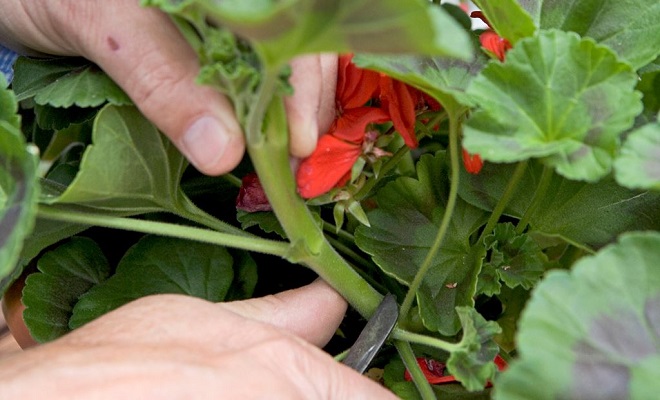
For lush flowering, mandatory pruning is required.
Why is royal geranium not blooming?
Many novice growers are wondering why royal geranium does not bloom. This can be due to improper care, frequent transplants and the presence of bacterial and fungal infections. First of all, carefully inspect the plant for dark spots on the leaves, cannon on the stems and rot in the root part. If signs of a disease are found, then the entire root system should be cleaned from the ground, rinsed under running water and placed in a weak solution of potassium permanganate for 2 - 3 days. Clean or remove all affected parts of the plant.
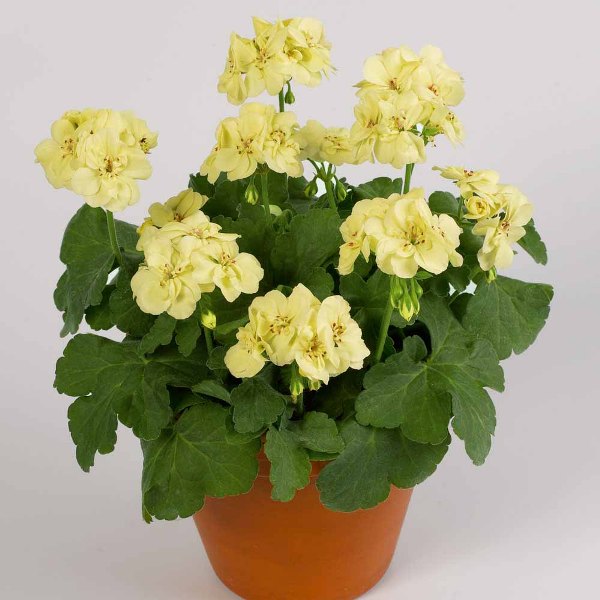
Prepare fresh soil. The pot, if the same will be used, should be disinfected with a solution of bleach. Disinfect the soil with boiling water before transplanting. Transplant the plant and carefully observe the emergence of new signs of disease.
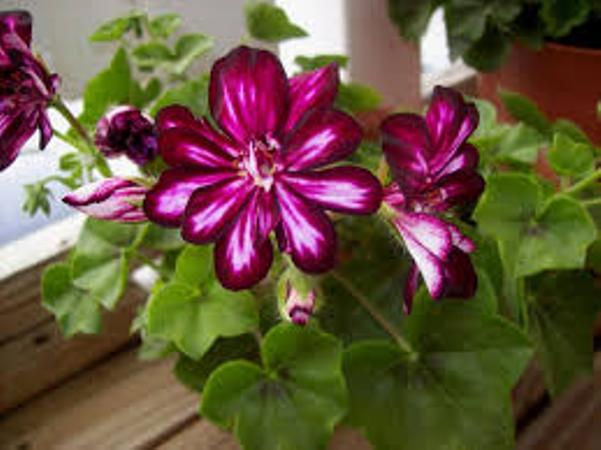
Also, royal geranium does not bloom if inadequate conditions for care and growth are provided. For example, excessive dryness of the air leads to systematic dropping of buds and peduncles. Their establishment occurs only if the soil contains sufficient phosphorus, potassium and manganese. With an excessive application of nitrogen, a quick set of green mass occurs and there is no flowering.
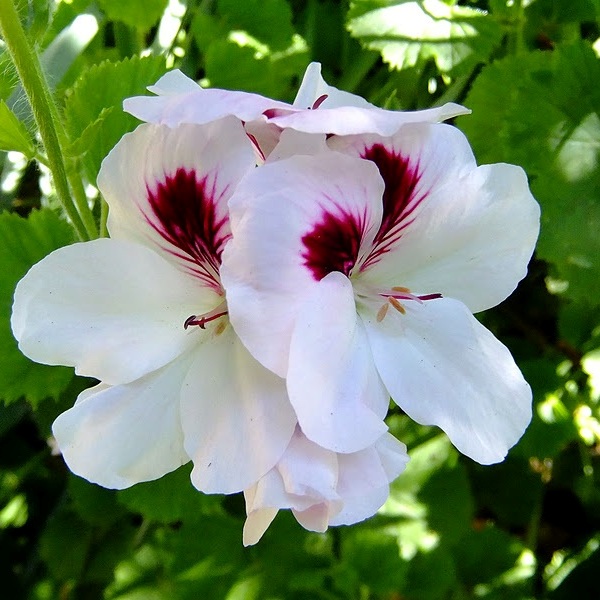
Another option, why royal geranium pelargonium does not bloom, is too large a container in which the plant grows. Tall, but not wide pots are more suitable for this indoor flower. This ensures long-lasting, profuse flowering. A large pot leads to overgrowth of green mass and lack of budding.
Geranium Care - Tips

Despite the fact that pelargonium is an undemanding indoor flower, nevertheless, it needs competent care. For full growth and abundant flowering, she will need good lighting, regular watering and frequent loosening of the soil.In addition, the main care of the plant includes feeding and removing faded buds and leaves. In order to get healthy and beautiful flowers, young bushes are pinched at the stage of the appearance of several leaves. In order to get a densely branching bush, the plant is planted in a large pot. In small pots, geraniums will delight you with rich flowering. Pelargonium, like many other indoor plants, is sold in pots filled with soil substitute. It is not advisable to immediately transplant the purchased flower into a new potting mixture. It will take him 2-3 weeks to adapt.
The transplanted flowers are sprinkled with soil, while, without tamping, they are watered a little. At first, the flowers are not fed.
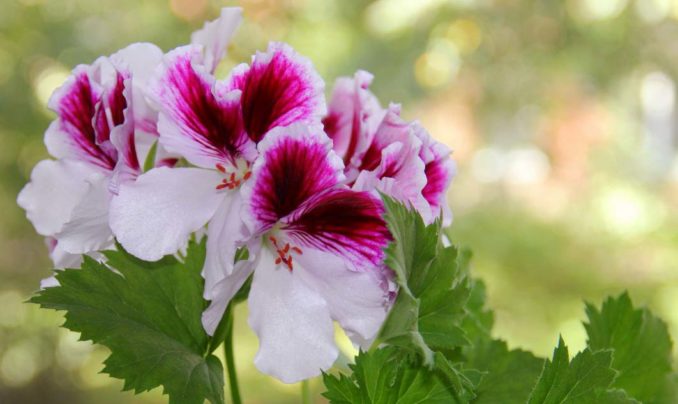
Geranium is unpretentious to the soil
When planting, it is extremely important to put a layer of drainage on the bottom of the pot. This will prevent rotting of the root system and stagnation of water at the bottom.
A neutral and slightly alkaline soil is perfect for the growth of pelargonium. If you add a little ash to the soil, this will reduce its acidity. Leafy and turfy soil mixed with sand and humus in equal proportions is an impeccable soil mixture for pelargoniums.
Proper care of flowers during the growing season is very important. It is not advisable to fertilize these flowers with organic fertilizers. Overfeeding can cause severe plant burns. What they need is mineral fertilizers. They are rich in potassium, phosphorus and contain a very small percentage of nitrogen.
Pelargonium needs frequent and moderate watering. Before each wetting, the top layer of the soil must dry out. In the cold season, flowers are watered no more than 1 time in three days, in the summer - every day.
It is important to know that geraniums cannot be sprayed. To increase the humidity in the room, put pallets with water
Royal geranium tolerates dry air much worse than other varieties of pelargonium. This variety needs special care.
A well-lit place is the key to active growth and abundant flowering of geraniums. Lack of lighting can lead to indoor plant disease, as well as a decrease in the number of flower buds.
In the summer, in the heat, the flower should be placed in a shaded place so that the leaves do not get sunburn. The south-facing windowsills are ideal for geraniums.
With the onset of summer, pelargonium is planted in the garden in the open field, where it can delight with its decorative appearance and bright flowers all season. The main thing is to provide her with proper conditions of detention and provide proper care. Geranium does not tolerate wind and drafts. In addition to this, an indoor flower, planted in the shade, will have small faded leaves and is unlikely to bloom.
Pelargonium is not geranium!
Are you surprised?
"How so? Everyone has been calling this flower geranium for 100 years, and our grandmothers called it that. "
The fact of the matter is that in the days of our grandmothers' youth, botanists were just beginning the process of classifying plants. First, the Geraniaceae family was identified, which included all the plants, the fruit of which is similar to the beak of a stork / crane (in Greek geranion - crane). And for all plants there was one name - "geranium".
Then the family was divided into genera, 2 of which are Pelargonium and Geranium, there are 5 of them in total. These two genera are radically different from each other.
The genus Geranium is a winter-hardy plant that is able to winter outdoors and grow mainly in Europe. Unlike Pelargonium, they are practically not grown at home. There is also a difference in the shape of the flowers - in geraniums, the structure of the flower is correct, symmetrical.
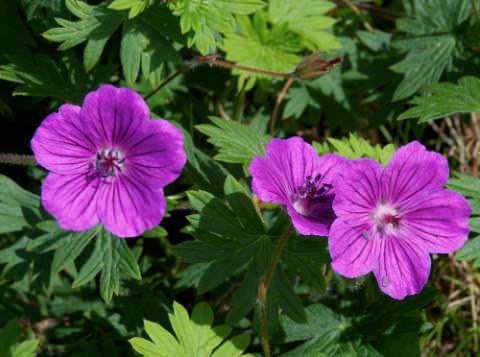 Geranium
Geranium
Pelargonium has an irregular flower shape - the upper 2 petals are usually slightly larger than the lower 3. They grow in regions where the temperature does not drop below zero, so they will not withstand frosty winters in the open field.
Breeding methods
 Novice florists are certainly interested in the question of how geraniums reproduce. To breed geraniums, use the tops, which have 3-4 pairs of leaves. They are obtained at the time when the plant is pruned. Rooting of cuttings in water should not be carried out. High humidity does not promote root growth, but can only lead to the fact that they simply rot. After cutting, processing is carried out using charcoal.
Novice florists are certainly interested in the question of how geraniums reproduce. To breed geraniums, use the tops, which have 3-4 pairs of leaves. They are obtained at the time when the plant is pruned. Rooting of cuttings in water should not be carried out. High humidity does not promote root growth, but can only lead to the fact that they simply rot. After cutting, processing is carried out using charcoal.
The cutting is dried and immediately planted in the ground. By the way, propagation by cuttings of royal geranium is the simplest, most effective and common method.
To breed with shoots, the soil for planting must contain perlite and peat in equal parts. The young plant is planted in a separate pot. You can also use a peat cup for this purpose. In this case, mass death is excluded due to improper care and reproduction. After 2 months, the plant will take root completely. Then it is transplanted into a nutrient substrate. Composition: turf, deciduous soil, sand, peat, taken in equal volumes. Covering with a jar or plastic bag is not required. Maintenance activities require regular watering and maintenance of moderate light levels.
In order for geraniums to bloom magnificently and fully grow, periodic feeding is required. It is better if mineral fertilizers are used, which have a low nitrogen content. When flowering begins, and it occurs 6-9 months after the plant has taken root, use those fertilizers that are used to feed flowering indoor plants. They are sold in any store with a given specialization.
general characteristics
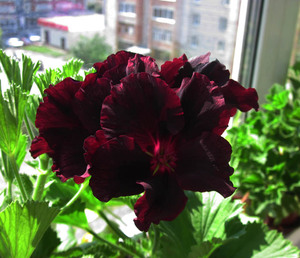 Anyone who has decided to seriously tackle this type of flowers will have to work hard, otherwise the expected result will simply not be.
Anyone who has decided to seriously tackle this type of flowers will have to work hard, otherwise the expected result will simply not be.
In the stems and leaves of this type of geranium, truly "royal blood" really flows. Its homeland is South America, but in Europe this plant appeared only in the VIII century. It so happened that royal geranium reached immense popularity among flower growers in the shortest possible time. This plant is extremely interesting for breeders. As a result of their hard work, which does not stop literally for a minute, the emergence of new varieties of royal pelargonium appears. Currently, there are such a large number of its varieties that it is rather difficult to name the exact number.
At home, pelargonium can reach a height of 60-80 cm. It is not worth it to grow bushes with a higher height, because the flowers are located only at the very top of the plant. If geranium grows to a height of 1 m, then it is characterized by the loss of all decorative properties. If you pursue only experimental goals, then you can try to grow a bush up to 1.5 m high. Surrounded by stunted plants, all contrasting features will fully manifest.
Planting and transplanting
It is necessary to transplant ivy-shaped geraniums every 2 years in the spring. At each transplant, it is necessary to change the pot so that it is slightly larger than the previous one. In this case, the composition of the soil should remain the same.
Procedure:
- Place drainage on the bottom of the pot. It can be broken bricks, pieces of foam.
- Remove the geranium along with the earthy clod from the old container. To facilitate this procedure, water the plant first, and when the water is absorbed, turn the pot over, holding the lump and the plant with one hand, and the pot with the other.
- After removing the plant, you need to carefully examine the root system so that there is no damage and decay. Remove all suspicious parts with scissors so as not to hurt healthy roots.
- Place the plant in a new pot, and fill the void between the walls and roots with a new and slightly moistened substrate.
- The soil near the root must be well tamped so that there are no voids.
- Water the plant with water at room temperature and place in the shade for 7 days.
- After a week, move the pot to a permanent place.
Possible growing problems
Even the most experienced growers are not one hundred percent protected from the problems that arise when growing royal geraniums. For beginners, it is even more difficult.
Drops buds and leaves
If the foliage and buds of the royal geranium begin to fall off, then with a high probability we can say that the room is too hot and the air is very dry. Also, these symptoms sometimes indicate insufficient lighting. You will need to turn on the phytolamp, put a humidifier and take measures to reduce the temperature in the room. If the house is cool, then it is enough to limit yourself to additional lighting and monitor the humidity.
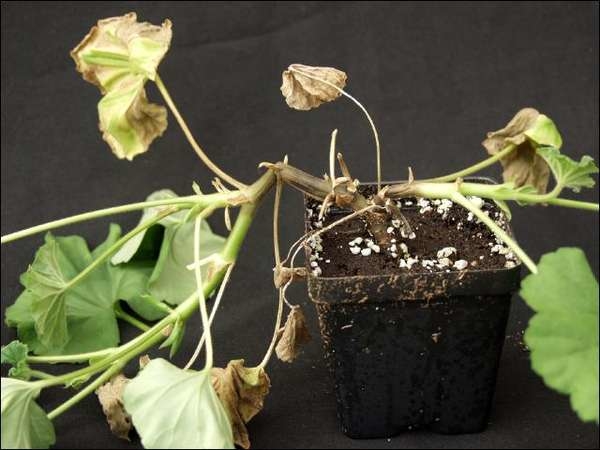
Due to the heat, the king geranium sheds leaves and buds
Leaves turn pale
A change in the color of the leaf plate is provoked not only by a deficiency of trace elements (in particular, nitrogen), but also by a lack of light, as well as excessive moisture. It is urgent to analyze these factors and eliminate the cause.
The tips of the leaves dry
Such a problem in royal geraniums most often occurs due to a lack of moisture. You should increase the number of watering and resort to humidifying the air, but you should not be too zealous.
The lower leaves fall
The fact that the lower leaves begin to turn yellow and fall off is caused by a lack of moisture or nutrients in the soil, as well as a lack of light, poor ventilation of the bush. Also, this symptom signals the decay of the root system, which can lead to the death of the flower.
Pests
Of the pests for royal geraniums, they pose the greatest danger:
- mite;
- weevils;
- whitefly;
- aphid.
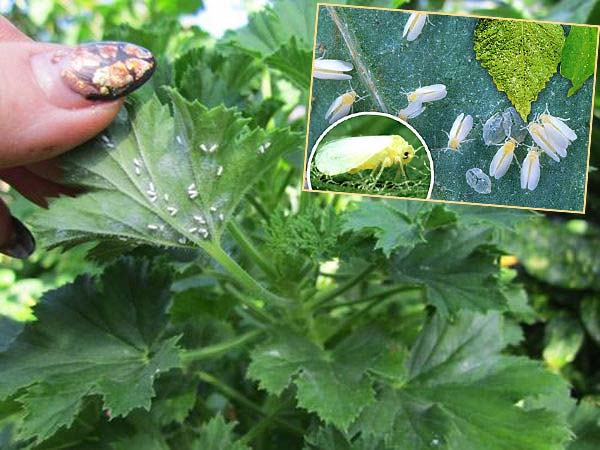
King geranium is susceptible to pests
To get rid of parasites, you should wipe the inside of the leaf plate with chamomile infusion and leave the plant for a couple of hours, then rinse everything off. If such actions do not bring a positive result, an insecticide is used. Step-by-step instructions for its use are contained in the attached documentation.
Other problems
Sometimes the trunk of a royal geranium begins to rot. This indicates that the plant is affected by a black leg. Excessive watering or low temperatures leads to the development of this ailment. Sick plants must be disposed of and the pot must be disinfected.
Sometimes flower growers wonder why geranium is green, but sluggish? First of all, you should immediately reduce watering. Otherwise, the flower will become bleached with gray mold. The scarlet shade of the leaves indicates low temperatures or the presence of drafts.
Care conditions
The plant makes increased demands on its maintenance and cultivation. Emphasis should be placed on four basic rules:
The plant does not tolerate both excess moisture and its lack. It should be protected from direct sun and strong winds. Experienced gardeners do not recommend planting this flower in open ground for the summer. They clearly will not approve of such hardening. But you can take out a pot of pelargonium on the balcony in the summer. It should be placed on the balcony so that it is not covered by partial shade, but direct sunlight does not act either. Otherwise, the plant can get sunburn.
The plant does not tolerate conditions in which there is a lack of light. This species cannot live at all in conditions of darkness. If there is not enough light, it will stretch out so that it will not have the strength to lay the buds at all. To get lush buds, the plant must be illuminated with special fluorescent lamps.
It is required to observe a certain temperature regime. In winter, the temperature should be kept between 12-15 degrees. The plant will experience discomfort if the room temperature exceeds 24 degrees. The most minimal unpleasant phenomenon will be the lack of flowering.
The extreme negative point will be a complete stop of growth.
Due attention should be paid to the activities associated with watering. How intensively soil moistening is required depends on temperature conditions
Water should be moderate and regular in summer. On the recommendation of experienced flower growers, watering is not carried out from above, but it is required to pour liquid into the pan. With overhead irrigation, the soil is compacted, and this phenomenon is very poorly tolerated by royal geraniums. The water must be defended. Rainwater irrigation is a good solution.
The drug Heteroauxin: instructions for using the solution
If you follow all these requirements, the plant will certainly thank you with good flowering. It will delight the grower for a long time with its beautiful, excellent flowers.
Flower reproduction methods
Geraniums can reproduce in many ways. However, grafting is considered an ideal option. This is the simplest and most effective procedure for maintaining the characteristics of the variety.
In addition, there are the following crop breeding options:
- seed method;
- dividing the bush;
- processes.
How to propagate geranium by cuttings at home
Geranium cuttings are considered the most affordable and effective method. It allows you to preserve the varietal characteristics of the culture. In this case, the plant must be provided with suitable conditions. First of all, it needs high temperature and good illumination.
First you need to prepare the cuttings. For this, shoots with a length of at least 10 cm are selected. The cut must be made in the middle, between two adjacent leaves. Prepared cuttings are not recommended to be immediately planted in a pot. First, the slices should dry slightly. But don't dry them too much. After the sections have dried, they should be treated with wood ash or sorbent. This will help prevent infection from entering the damaged area.
Important! When propagating a plant in this way, before planting a cutting, it is worth cutting off the lower leaves.
Flower propagation by cuttings has many benefits.
Rooting methods
Cuttings can be planted in dry soil or water. In the first case, small containers are used, in the bottom of which it is imperative to make holes and organize a drainage layer. Loose soil is used as a substrate. To get it, you can mix turf, garden soil, sand, humus. It is also acceptable to use a universal substrate. You can buy it in specialized stores.
It is permissible to root plants in water. In this case, the cuttings are placed in a vessel filled with water. Previously, it is recommended to add a means to stimulate the appearance of roots. The cuttings must remain in the water until the first roots form. Then they need to be planted in a pot in a permanent place.
Planting in the ground and further care
To transplant a culture into the ground in a container, you need to make a deepening, place a stem in it and compact the earth
It is important to consider the composition of the substrate. It must contain peat or sand
It is important that the soil is as loose as possible. To stimulate growth processes, you can create a greenhouse effect for the plant. It is achieved with a plastic bag.
It is strictly forbidden to use fresh organic fertilizers for geraniums. These include manure and humus. Such feeding will stop the flowering process. Complex mineral preparations are used to fertilize geraniums. To make the flowering more lush and long lasting, it is worth using products with potassium content.
Stable growth of a flower after reproduction is impossible without trace elements such as zinc, iron, calcium, etc. Fertilizers should be applied 2 times a month.
Important! In the summer heat, top dressing is not applied. This is due to the fact that the plant is under stress.
Geranium tolerates any moisture parameters normally.It takes root and develops well, delighting with abundant and lush flowering
In this case, it is important to ensure that water does not fall on the leaves of the plant.
When propagating geraniums by cuttings, the following should be considered:
- for watering plants, it is worth using exclusively warm water;
- only wilted bushes should be covered from the sun;
- it is necessary to root the plant at a temperature of +15 degrees;
- you can propagate a flower for a whole year, but maximum efficiency is achieved in spring;
- for group plantings, an interval of 15-17 cm between plants is observed. This will help to achieve rapid flowering.
Geranium needs high-quality and proper watering
Young plants take root in different ways. It depends on the specific variety. Zonal and ivy crops take root the fastest. It takes a month to adapt royal pelargonium. Fragrant geranium takes root after 1.5 months. In this case, the flowering of angelic and royal species occurs in a year.
Watering
When watering pelargonium, it is important to remember that these are rather drought-resistant plants, at the same time they are easily susceptible to fungal diseases. Therefore, it is better to underfill the plant a little than to water it in excess.
In summer, water as the top layer dries, provided that the plant is in a warm and sunny place. In winter, in cool conditions, watering should be limited, but not brought to complete drying of the soil.
Signs of excessive watering will be lethargic drooping leaves, often with signs of gray rot; in a severe case, stem rot will begin, which almost always leads the plant to death. Another symptom of excess moisture is the appearance of "sores" on the underside of the leaves. When the earthen coma dries out, the plant stops blooming, the leaves turn yellow, their edges dry out.
Air humidity for pelargonium is not important, these plants do not require spraying. Excessive dampness and stagnant air can cause fungal diseases.
Transplant rules
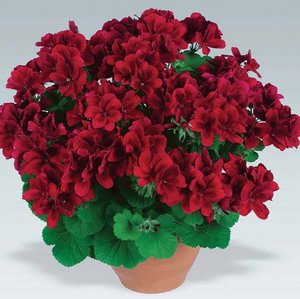 Royal geraniums are very unfavorable to various movements. The transplant is carried out in exceptional cases. It is better not to disturb the plant at all. But it so happens that you still have to sit down. For example, there may be cases in which the root system has grown so intensively that it simply did not fit into the pot. In this case, of course, the plant must be transplanted.
Royal geraniums are very unfavorable to various movements. The transplant is carried out in exceptional cases. It is better not to disturb the plant at all. But it so happens that you still have to sit down. For example, there may be cases in which the root system has grown so intensively that it simply did not fit into the pot. In this case, of course, the plant must be transplanted.
A transplant is recommended every 2 years. If this requirement is not met, then the plant may stop flowering or there will be an insignificant amount of flowers. The best time for transplanting is the very beginning of February. The soil should be prepared, which will consist of peat, deciduous land, sod land and river sand. Good drainage is essential. Expanded clay or river sand is best suited for this purpose.
Photo of royal geranium and description
In the proposed photos, the royal geranium is presented in various variations of varieties and selections. This plant is a favorite with flower growers from all over the world. Therefore, new varieties with the original color of the petals are constantly appearing. Terry royal pelargoniums are more common. They have a rich color of petals and a wide spherical shaped cluster of peduncles.
In the photo of the royal pelargonium, you can see the Pink Mikado cultivar. It is distinguished by its compact bush size, rich dark green leaves and a slight pubescence of the stem. Coloring of petals from pastel pink to rich salmon shade. In the center of each petal there is a dark oval speck that gives out royal pelargonium.
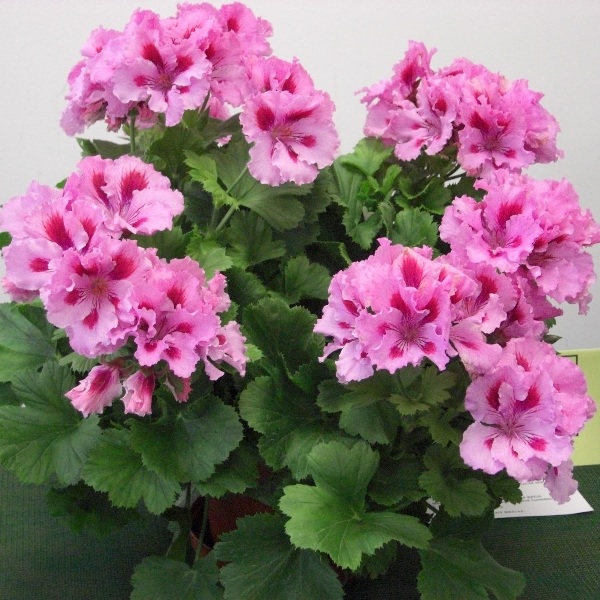
pictured royal pelargonium
The next photo shows Aristo Schoko, a royal geranium variety that has a rich red petal color. In the center of the cervical part of each petal there is a bright oval-shaped and dark red spot.
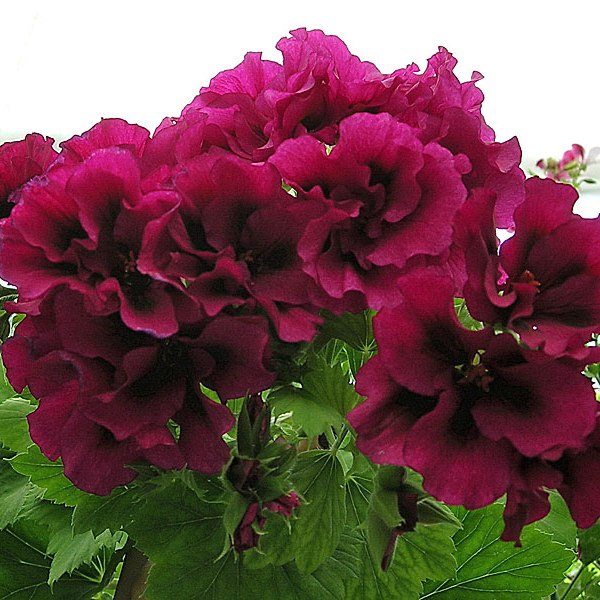
If you want an exotic look, then check out the photo of the royal geranium of the Barkarole variety. This is a bright motley color with a real riot of colors. The edging of each petal, which has a silvery sheen, gives the variety sophistication and exoticism. The edging of the buds, combined with the vibrant yellow, orange, white and pink petals, gives the royal geranium flower an attractive appearance. It is widely used to form harmonious interior designs in apartments, country houses and offices.
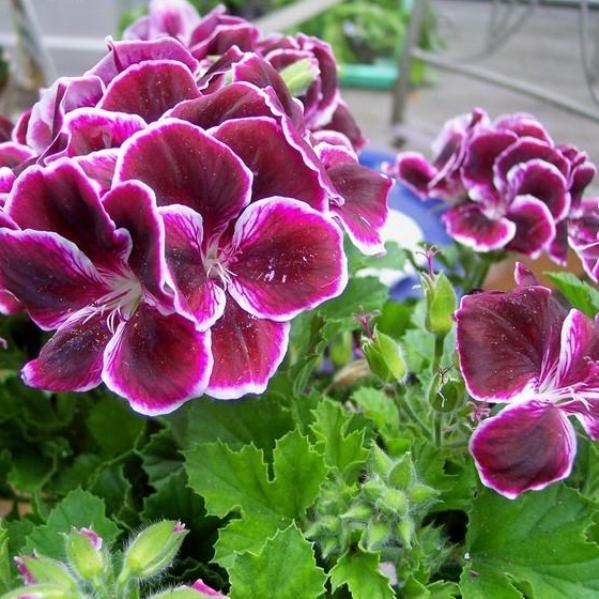
For lovers of classic interior design options, there is the Imperial variety. In the photo you can see compact plants with delicate beige petals that adorn the pink saturated spots in the center.

For the first time, royal pelargonium was introduced to Europe at the end of the eighteenth century. Since then, breeding work has been endlessly going on, as a result of which all new hybrid forms of this plant appear. Therefore, the varieties of royal geranium listed above are far from a complete list. These are simply the most popular and sought after varieties.
The general description of the royal geranium pelargonium includes information about the average height of the adult plant. In most cases, at home, royal pelargonium reaches a height of 60 - 80 cm. It is not advisable to grow a taller plant, since the buds are located only at the apical points of growth. At a height of 1 meter, the decorative properties of an indoor flower are completely lost. However, in a garden, you can grow a one and a half meter bush as an experiment. But it is better to use it as a background for low-growing flowering plants.
The special chic of royal pelargonium, judging by the description and cultivation practice, is the inflorescence of the buds. They can be up to 25 cm wide. But this is with proper care at home. On average, these are standard inflorescences with a diameter of up to 15 cm. The length of the peduncle can reach up to 10 cm. The more mineral fertilizers of the potash and phosphorus groups are introduced during the preparation for flowering, the larger the diameter of the inflorescence and the shorter the length of the peduncle.
A distinctive characteristic is the presence of a dark, saturated color of an oval spot in the center of each petal. By their structure, the flowers of royal pelargonium can be either simple or double. In shape, the petals can be with a light wavy structure or flat concave. There are forms of crimped royal geranium flowers. The leaves are serrated, oval or rounded. The leaf has a rough surface with slight pubescence. The color of the foliage depends on the condition of the plant. A healthy indoor flower has rich emerald foliage that tightly covers the central trunk and all shoots.
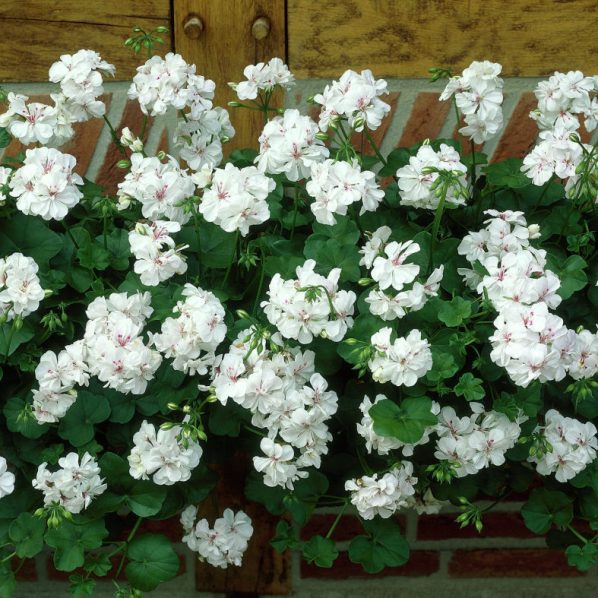
Bud shades can include dazzling whites, reds, pinks, purples, yellows, oranges. The flowering period is not long and is a maximum of 6 months. The indoor flower geranium royal begins to bloom in early March.
How to propagate geranium
Seeds

Geranium propagation is carried out in two ways: using seeds and cuttings. The first method is less popular and more applicable for breeding new types of pelargonium. Plants with very different decorative qualities can grow from seeds of a certain variety.
For planting seeds, take a soil mixture from loose soil, humus and sand. Sowing of planting material is carried out in early spring. For early planting, it is advised to use artificial light bulbs. For the prevention of diseases, the soil is disinfected before planting, spilled with a weak solution of potassium permanganate (potassium permanganate). The sown seeds must be sprinkled with a thin layer of soil - 2-3 mm. Further care of the seedlings is to create greenhouse conditions for their successful germination.
Cuttings

Geranium propagation by cuttings is performed in spring or in the first half of summer.For planting, it is necessary to use only apical shoots with several leaves. Young shoots are placed in a glass of warm water until rooting. Rooted cuttings are planted in the ground. After they take root and finally get stronger in the ground, they pinch off the apical shoot to create the correct shape of the bush and the formation of new shoots. In addition, many gardeners cut balcony flowers for the winter in order not to bring boxes into the house. To do this, the shoots are cut at the root, divided into cuttings with several nodes and placed in cassettes or disposable cups on the windowsill. By spring, the cuttings take root, grow, and even the first bud appears. By the new season, they can already be planted again in boxes and tubs. Such geraniums are in extremely high demand in the market - you can get additional income.
Geranium is an amazing colorful flower, caring for which does not require special efforts and costs, and most importantly, it is resistant to diseases and pests.
Good luck to you!!!

